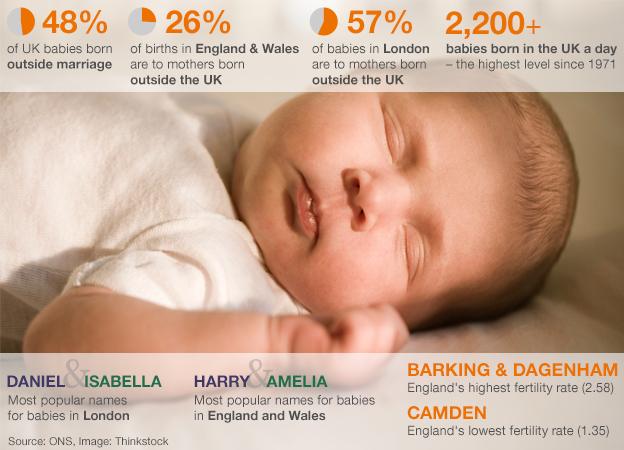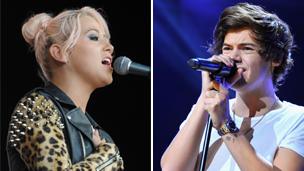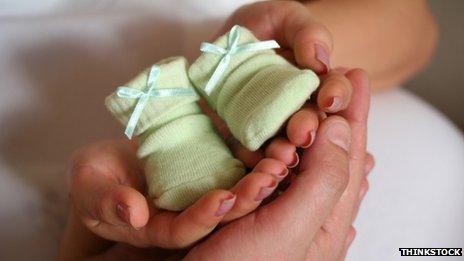Royal baby: An average baby?
- Published
There's nothing "average" about the royal baby, of course, and every parent thinks their newborn is uniquely special.
About 2,200 other babies are born each day in the United Kingdom. We are in the midst of a baby boom, more births than Britain has seen since Chirpy Chirpy Cheep Cheep topped the charts in 1971.
But how does the infant now third in line to the throne compare with all those commoner babies born in Britain on the same day?
Well, in being described as "white British", external, the royal baby is in the minority among newborns in the capital. Only 30% of London babies are placed in that ethnic category, with about half (49.5%) being the offspring of two white parents.
However, the young prince is among the majority across England, where the figure for white British babies is 65%, and 73% of new-borns are described as "white".

The royal baby is also unusual for London in having a mother originally from the UK. Most babies delivered in the capital these days (57%) are to mothers born overseas, external. The figure for the City of Westminster, the borough where the Duchess of Cambridge had her baby, is 73%. Across England and Wales, however, it is 26%.
The fact that the royal baby's parents are married places him in a minority in much of the UK. Most children are now born outside marriage or a civil partnership, external in Scotland (51%), Wales (58%), the North East of England (59%), the North West of England (54%), Yorkshire and Humberside (52%) and the East Midlands (51%).
The parts of the country where babies born outside marriage are in the minority are the West Midlands (46%), the East of England (45%), the South East (43%), Northern Ireland (42%) and London (36%). In the borough of Westminster the figure is just 25% - three-quarters of all babies born at St Mary's in Paddington are likely to have parents who are married.
In choosing to have their baby in Westminster, the duke and duchess have chosen a corner of Britain with one of the lowest fertility rates. Women in their child-rearing years in the borough are currently expected to have, on average, 1.37 children. Only Camden, in north London, has a lower rate at 1.35. The figure for inner London is 1.65.

Amelia (as in Lily) and Harry (as in Styles) are most popular baby names in England and Wales
However, the figure for England is currently 1.94 - up from 1.64 a decade ago but still well below the figure for 1964 of 2.93. On the other side of the capital from the royal baby, Barking and Dagenham has the highest fertility rate in the country at 2.58.
If the Duke and Duchess of Cambridge decide to go with the crowd in choosing a name for their child, the most popular name for a boy in London is Daniel. Across England and Wales the most common is Harry, external (for girls, it is Isabella in London and Amelia across England and Wales).
If the royal couple decide to pick a name rising rapidly in the popularity stakes, they might be tempted by Kayden - which jumped 1,000 places in a year to reach number 94 in the boy's list.
Prince Kayden would have attracted long odds at the bookies, however.
The royal baby, weighing in at 8lb 6oz, is larger than the average, although the average birth weight of UK babies is increasing - 7lb 8oz for boys (up 2oz since Middle of the Road were driving us mad with their cheeping in 1971) and 7lb 4oz for girls (up 1½oz).
We still tend to measure babies in imperial units for some reason, but for those who prefer grams, the averages are now 3.4kg (boys) and 3.3kg (girls). The new royal child weighs about 3.8kg.
Babies tend to be bigger or smaller depending on the region they are born. So in the South West of England, for instance, 44% of babies weigh more than 3.5kg (7lb 11oz) while in London it is 37%.

As a 31-year-old mother, the Duchess of Cambridge reflects the average for a married woman having her first baby (30.7). Among unmarried mothers, the average is 27.6. Back in the Chirpy Chirpy Cheep Cheep days of 1971, the ages were 24 and 23.8 respectively. Among women of Kate's age, 55% have had at least one baby.
As a 31-year-old father, Prince William is far from unusual - 65% of babies are born to dads who are over 30, external and the average of all fathers at the birth of a child has increased from 30.8 in 1991 to 32.6.
In some respects, then, the royal baby is entirely average. In others, totally unique. But, of course, that is true of every single one of the 2,200 babies born in Britain on the same day.